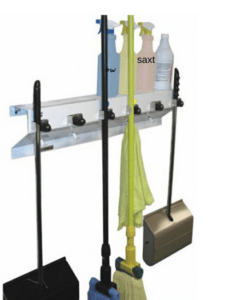Review of WHMIS 2015
- Labels have DANGER for high risk hazards and warnings for lower risk hazards. For example a danger risk may include: ‘may cause cancer’ or ‘fatal if inhaled’.
- There are five types of precautionary statements which indicate safeguards against a hazard. These include: general, prevention (protective gloves, safety glasses etc), response (including first aid), storage & disposal.
- If you empty a larger container into a smaller one for use, the secondary container must be labeled to indicate the contents.
- All employees need up-to-date certification.
A pictogram of the warning labels serves as a reminder to employees – if it is near the labels themselves it is easy to review the material regularly. For a free pictogram download see https://www.ccohs.ca/products/posters/WHMIS2015/
For more information see the Canadian Centre for Occupational Health and safety website http://www.ccohs.ca
It’s a service area – do shelves and hangars matter?

One of my favorite compactor rooms has a hose coiled on a hangar, a storage shelf for all cleaning products. There is a drying rack for the clean cloths and a hanging area for mops. The super knows the building well and can deal with problems before they become complaints. This makes odor management easier because tools can be located quickly and supplies re-ordered before they run out.
Other compactor rooms can have a way of filling up; perhaps some things were left on their way to their final destinations, others may be “inherited” from the previous super so the new team is not sure whether they will be needed or not. Cleaning products are generally stored there; however, without a clearly designated area, sometimes several containers of similar products are open and in various stages of being used up.
Is there a cost savings?
A hose hangar does not cost much compared to the price of a professional hose but it prevents the hose from being driven over by the bins which can cause kinks and pin holes. A shelf for cleaning products is also cheap – if you don’t have a storage shelf yet, one will probably appear ready to be thrown out when someone is moving. This is a good place for the poster reminding staff what the hazard pictograms mean. Cleaning the compactor room requires specialty products and some of these need protective equipment such as gloves. Having a package of gloves, safety goggles and other safety items right there serves as a good reminder to use them.

To improve organization, having a management plan helps
- Communicate the benefits. Have direct conversations about safety, morale and efficiency of a clean area
- Find out the bottlenecks. Are there things that are needed: tools? time? training?
- Is there enough lighting?
- Create a cleaning plan
-
- to fix the bottlenecks and
- to determine the time needed for the task
- Follow up – after cleaning find out if there are new issues that came up or help that is needed.
Finally, providing time to clean a workspace at the end of every day makes the morning better. If more than one person shares equipment this can help make all people feel responsible for it. If you have different staff on the weekend, end of day cleaning can really improve Monday morning morale.
For information about how to make cleaning easier read more how-can-we-clean-more-often
